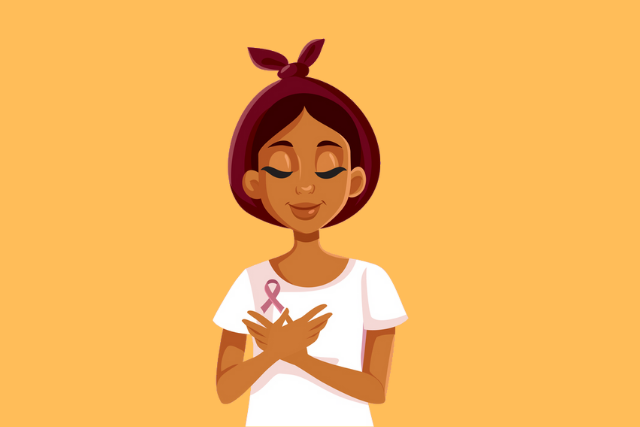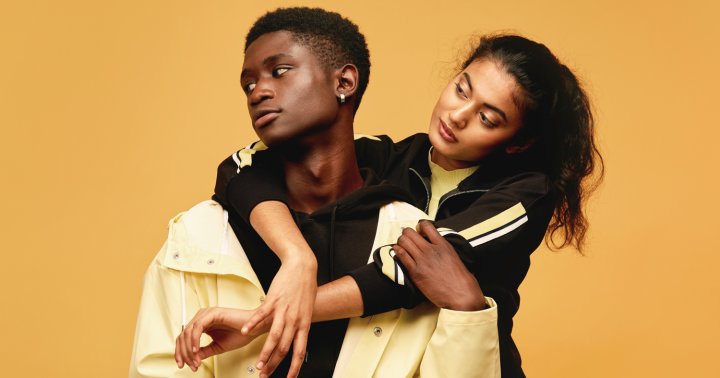How to do Frog Pose in Yoga – Proper Form, Variations, and Common Mistakes
The post How to do Frog Pose in Yoga – Proper Form, Variations, and Common Mistakes appeared first on The Yoga Nomads.

Frog Pose (Mandukasana) is a major hip opener that deeply stretches out your hip flexors and inner thighs for more mobility. Essentially a face-down, wide-knee squat, this is an intermediate to advanced level yoga pose with some alluring health benefits like building core strength, alleviating back pain, and even improving your sex life.
However, Mandukasana is one of those yoga poses that require a bit of work to achieve. There’s no denying it: Frog Pose is hard as hell. It tests you physically and mentally (after all, traditional Ayurvedic knowledge says that we store much of our negative emotions in the hips).
But with a few modifications, props, and tips, anyone can reap the benefits of this asana as they work toward full expression.
A word on the two frog poses: Mandukasana (the squatting, thigh-opening Frog Pose) and Bhekasana (the belly-down, deep thigh stretch) are often used interchangeably to describe “Frog Pose”. This post covers Mandukasana, or the Squatting Frog.
Pose Benefits
For what seems like a simple groin-opening, willpower-testing position, the benefits of Frog Pose are pretty impressive…
More hip mobility: This hip opener targets all the major muscles and tendons of the hip joint. Frog Pose restores internal rotation for greater flexibility and less tension.Core strengthening: Studies show that asanas like Frog Pose stimulate your internal digestive organs while challenging core strength. As you use your arms to push backwards into a deeper groin stretch, you engage your abdominals to keep you stable.Help with back pain: When you have tight hip flexors, low back pain comes along for the ride. Mandukasana can counteract the impacts of a sedentary lifestyle by lengthening the sciatic nerve from your low back throughout your hips. The result? Less back pain from those long hours of sitting at a desk.Improved mental health: Frog Pose requires extra focus on deep breathing. If you get too deep into the pose, the intensity of the stretch can make breathing harder. But as you back off a bit and begin to breathe deeply, you can experience more awareness, less anxiety, and an improved mood.Increase circulation: Expanding the chest and heart downward can help improve circulation and boost blood flow.Improve your sex life: None of us imagined that a pose as un-sexy as Frog Pose could do anything for us in the bedroom. But you’ll be happy to know that this asana can amplify your sex life by strengthening the pelvic floor and increasing flexibility. Frog Pose targets your hip adductors (inner thighs) and loosens up the groin muscles to open the possibilities for more sexual exploration. After all, Mandukasana is centered around that juicy Sacral Chakra.
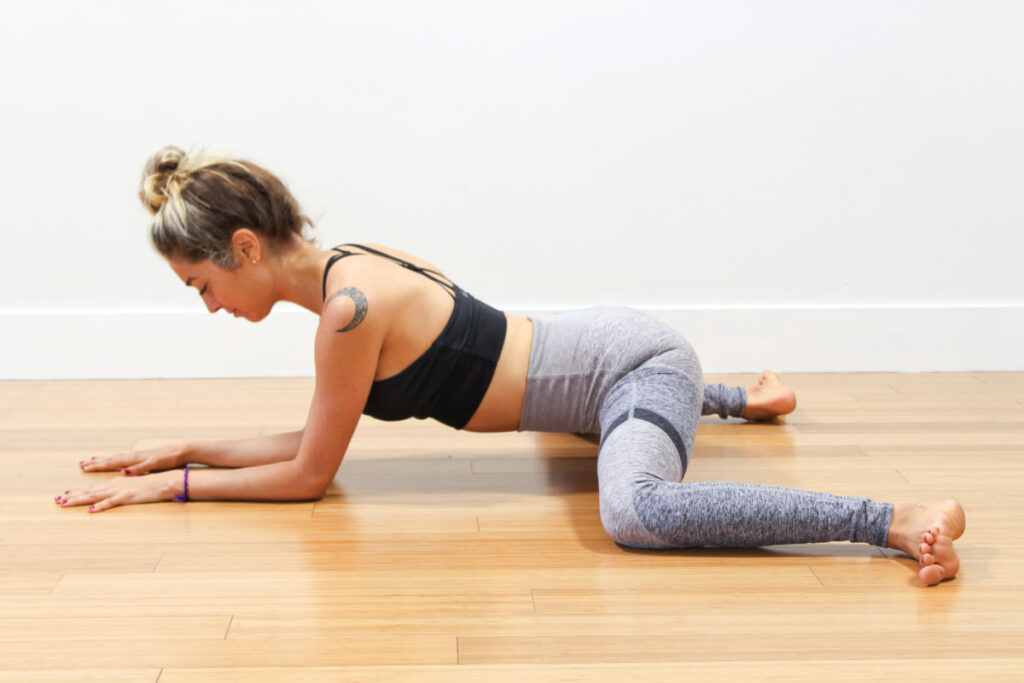
Step-by-Step Instructions
Getting into Frog Pose is relatively easy as long as you have thoroughly prepared your hips with preparatory poses. Those with sensitive knees may want to have some yoga blankets or yoga knee pads handy.
Start in a tabletop position with your knees beneath the hips and wrists beneath your shoulders.As you exhale, slowly begin to widen your legs out to the side, keeping your knees bent and feet pointing outwards.If you feel pain in your knees from pressing against the floor, place a pad or blanket underneath.As you begin to feel a deep stretch in your inner thighs, stop pushing for a moment to settle into the posture. On an inhale, use your hands and core to stabilize as you back out a little bit and bring your knees closer together.On the next exhale, push down to spread the knees a little more, being careful not to strain past your comfort zone.Turn your feet sideways so the inner arches are touching the floor.Lower down onto your forearms, palms flat as you breathe. Release the neck and rest into the position.Use your arms to leverage your body forward to reduce the stretch or backward to intensify it.Hold for 5-10 breaths. If it is hard to breathe or the stretch is too intense, back out before continuing.To get out, straighten your arms and raise the upper body first. Then sit backward as you walk your knees back towards each other.
Tips for mastering the pose
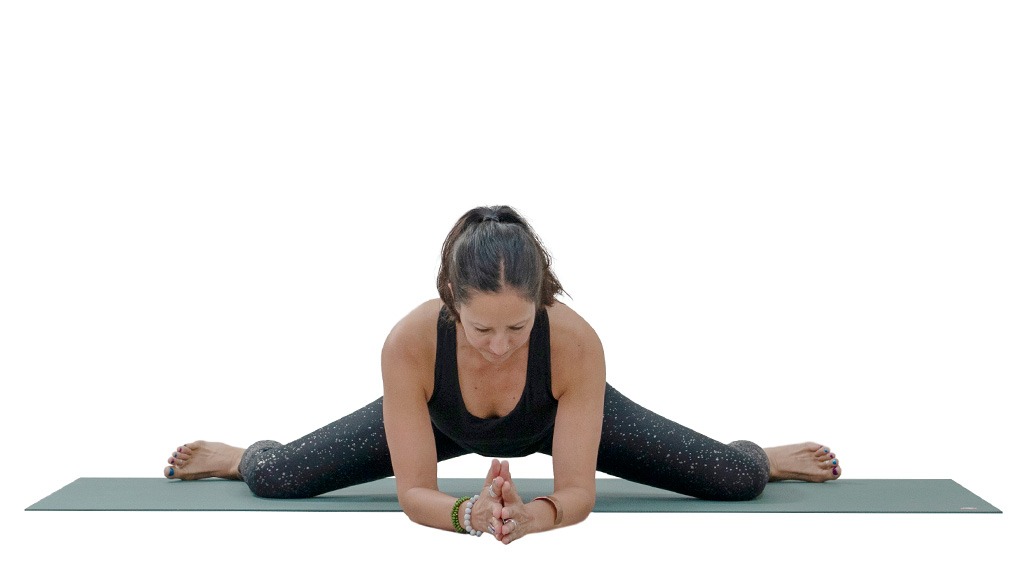
Though it looks a bit like a combo between a floor twerk and a bent-knee middle split, Mandukasana has a lot more going on than just a crazy thigh stretch. Mastering this pose requires regular practice and a special attention to form. Here are the top tips from certified yoga instructors:
Start simple and ease into it
Yoga shouldn’t be painful. Period. It’s a lot better to ease into this hip opener to allow your hips and groin muscles to get used to such an extreme stretch.
You can start in a wide-legged Child’s Pose and work from there. As you spread your knees, flex your inner thigh muscles slightly inward to keep from going too deep. Bring your hands forward or backward to adjust the intensity of the stretch.
Modify with props
If Frog Pose is too intense for your hips at their current level of flexibility, don’t be afraid to toss in some props to make yourself more comfortable. A couple of yoga blocks under the forearms, yoga blankets under the knees, or a bolster beneath the upper body can work wonders for making this pose more relieving and enjoyable.
Avoid practicing Frog Pose after eating
Though this pose stimulates digestion before mealtime, it can be pretty uncomfortable if you just ate before hitting the mat. Wait a few hours after eating before practicing Frog Pose.
Common Mistakes
You don’t have to be an ultra flexy-bendy yogi to do Mandukasana. If you want to maximize the many benefits of the pose as you work toward a Full Frog Pose, check for these common mistakes and fix them right away:
Mistake: Forcing the knees apart
Beginner yogis may find themselves trying to force their legs apart in an uncomfortable position as they try to get closer to the ground.
How to Fix It: Only lower your body as far as it will allow. Rest on your elbows to keep your body propped up and prevent your knees from spreading too far. It may not look like the perfect yoga photo, but as long as you feel the stretch and are breathing deeply, you will benefit from Frog Pose.
Tip: Be sure that your mat has plenty of traction so your knees don’t accidentally slip too deep into the hip-opening posture. You can also try yoga knee pads to add cushion and a non-slip grip.
Mistake: Forgetting to breathe
Pranayama deep breathing is crucial for all parts of your yoga practice, but it is especially important to practice deep belly breathing as you feel your hip flexors open and internally rotate.
How to Fix It: to back out of the pose, gently bring your hips up and back as you press your forearms into the yoga mat. If you are holding your breath, it could be a sign that the position is too extreme for your current flexibility.
Tip: Practice use inhales to lengthen and extend the spine, then exhaling to deepen the stretch.

Mistake: Overarching your low back
Overextending the low back can be painful and potentially cause an injury. It also makes you skimp out on the core workout and back pain relief benefits of the posture.
How to Fix It: Get the low back completely flat by slightly tilting your pelvis down and forward as your thigh muscles spread open. Imagine your tailbone subtly tucking toward the back of the room rather than arching to the sky.
Tip: To ensure that your low back is supported, engage the core and imagine that you are pulling your belly button toward your spine.
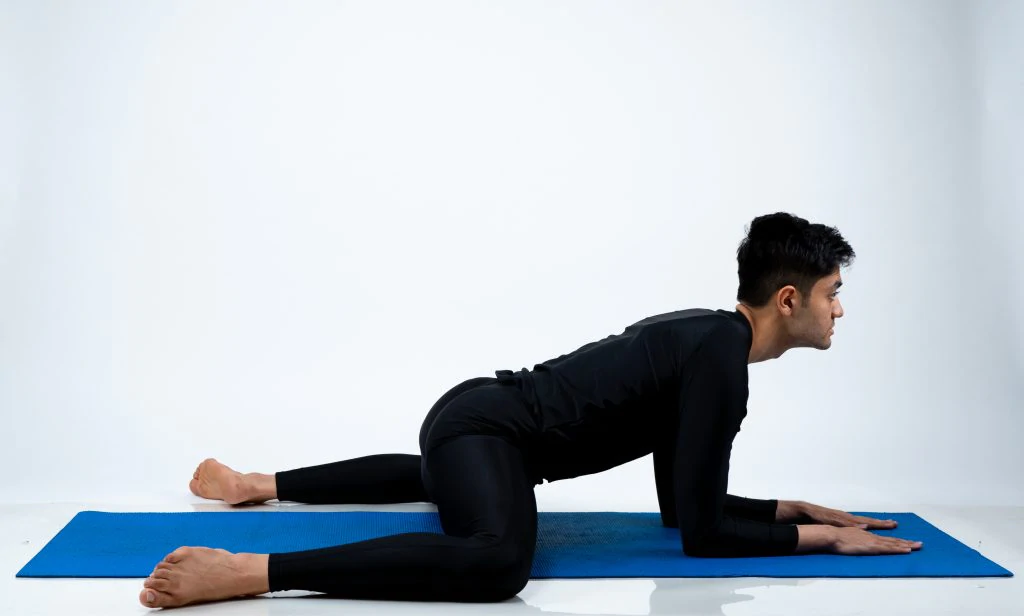
Modifications and Variations
Frog Pose can be modified for just about every level of yoga practice. All of these variations begin from a starting position on all-fours.
Restorative Half Frog Pose
The easiest variation of Mandukasana involves bending one leg forward and then lowering your stomach to the ground to gently stretch open one hip at a time. In this example, notice how her left foot is rotated so the toes point outwards.
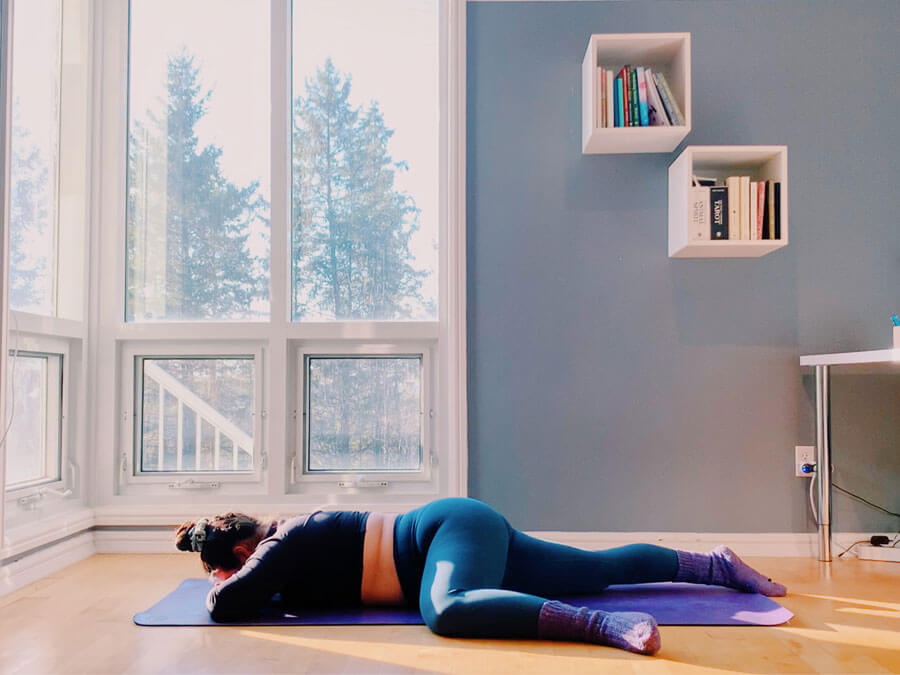
Bolster-Supported Frog Pose
This is the best option for those with sensitive joints. Grab two yoga bolsters or pillows and tuck them beneath your knees as you slowly slide them apart. Don’t forget to press your elbows into the yoga mat. Keep your shoulders and core engaged to prevent yourself from sinking too deeply.
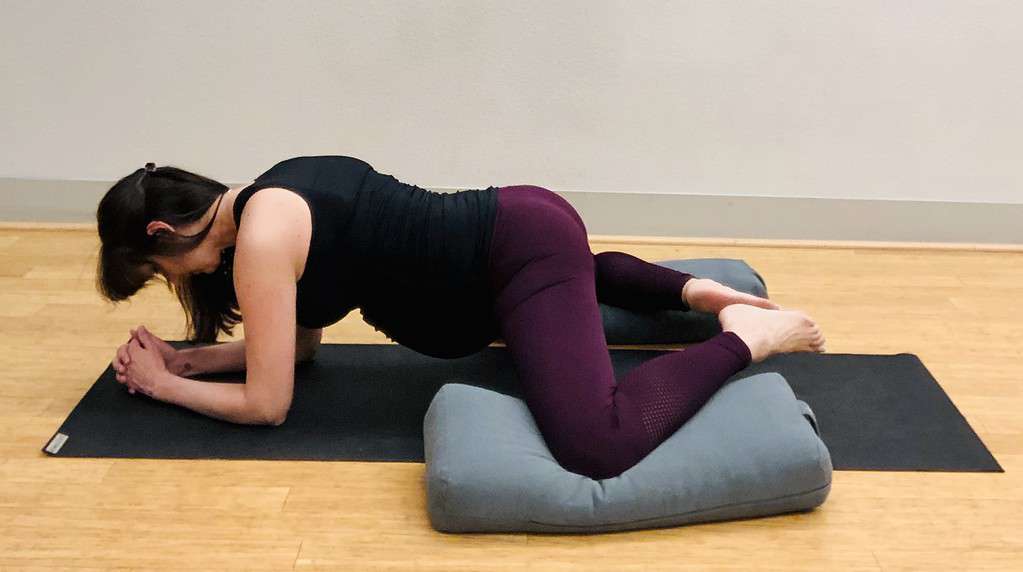
Block-Supported Frog Pose
Blocks beneath the elbows or the knees bring the floor up closer to your limbs. This variation is easier to hold for longer periods of time
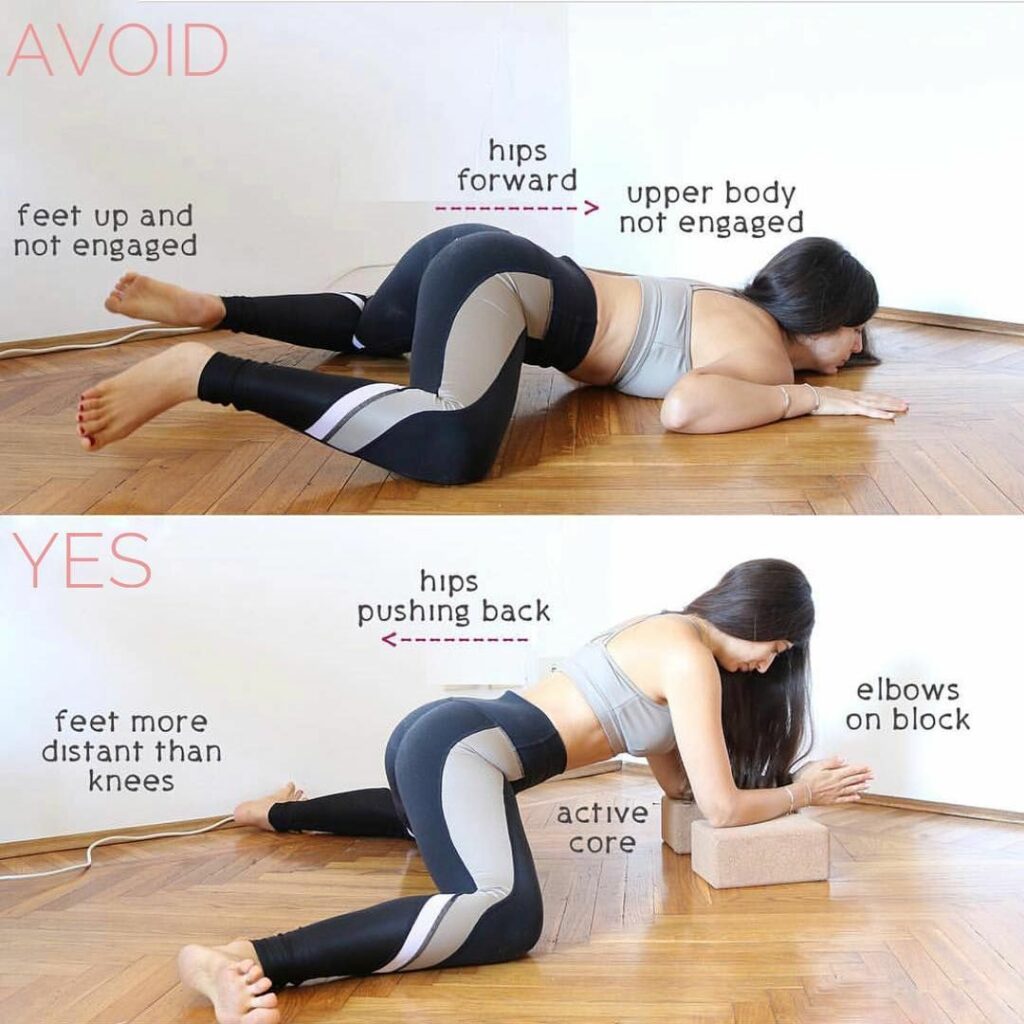
Teaching the pose – Help your students with these cues
With a yoga pose as intense as Frog, it’s very important to properly to help your students safely enter the asana with correct cues. Luckily, this asana doesn’t require any complicated left or right jargon. Use these tips to teach the pose more clearly:
From tabletop position, go down onto your forearms first for an easier entry into Frog Pose.Keep your arm muscles engaged and use them as leverage to adjust the intensity of the pose.Let your inner feet release into the floor as your toes roll outward.Use your breath to engage your core while simultaneously releasing tension in your hips and groin muscles. Imagine your abs firmly flexing as your hip flexors let loose in the wind.For a deeper stretch, try widening your knees and feet a bit further apart and letting the hips descend toward the floor.Ancient yogic philosophy says that many of our emotions are stored in the hips. As you breathe, notice if any past memories or feelings are coming up for you. It’s completely normal to feel a sudden intense emotion or the need to cry. You can rest in Child’s Pose if needed.Preparatory poses
Nobody jumps right out of bed and leaps into a Frog posture. Preparing for Frog Pose requires sufficient warming of the hip joints through internal and external rotations:
Happy Baby Pose (Ananda Balasana)Pigeon Pose (Adho Mukha Kapotasana)Butterfly or Cobbler’s Pose (Baddha Konasana)Goddess Pose (Utkata Konasana)Counter poses
After holding Mandukasana for 5-10 breaths, press your palms into the floor to ease your chest up from the floor and slowly come out of the posture. These counterposes help reduce any stress in the back and return the body to a homeostatic state.
Child’s Pose (Balasana)Garland Pose (Malasana)Wind Removing Pose (Pavanamuktasana)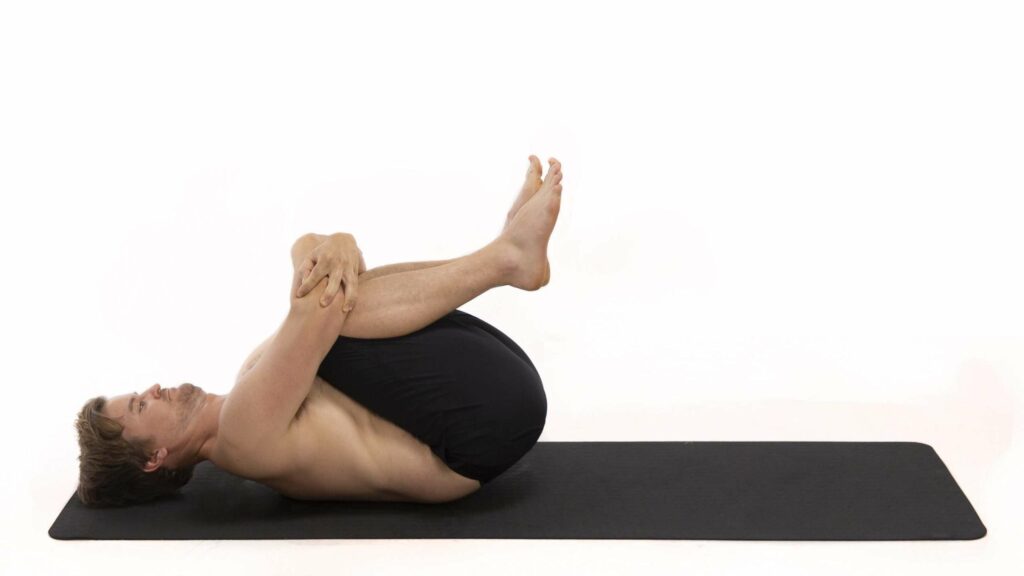 Downward Facing DogReclining Bound Angle PoseCorpse Pose (Savasana)
Downward Facing DogReclining Bound Angle PoseCorpse Pose (Savasana)Conclusion
Whether you’re seeking more limber joints, mental well-being, or a better sex life, Frog Pose will undoubtedly open your hips and challenge you to focus on your breathing. This intermediate-level asana could be the secret to less back pain during the work day or even your journey toward the yoga splits.
Namaste!

 JimMin
JimMin 







